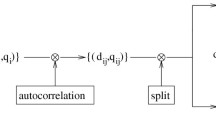Abstract
In a previous paper, we presented the ElectroShape method, which we used to achieve successful ligand-based virtual screening. It extended classical shape-based methods by applying them to the four-dimensional shape of the molecule where partial charge was used as the fourth dimension to capture electrostatic information. This paper extends the approach by using atomic lipophilicity (alogP) as an additional molecular property and validates it using the improved release 2 of the Directory of Useful Decoys (DUD). When alogP replaced partial charge, the enrichment results were slightly below those of ElectroShape, though still far better than purely shape-based methods. However, when alogP was added as a complement to partial charge, the resulting five-dimensional enrichments shows a clear improvement in performance. This demonstrates the utility of extending the ElectroShape virtual screening method by adding other atom-based descriptors.



Similar content being viewed by others
References
Armstrong MS, Morris GM, Finn PW, Sharma R, Moretti L, Cooper RI, Richards WG (2010) Electroshape: fast molecular similarity calculations incorporating shape, chirality and electrostatics. J Comput Aided Mol Des 24(9):789–801
Ballester PJ, Finn PW, Richards WG (2009) Ultrafast shape recognition: evaluating a new ligand-based virtual screening technology. J Mol Graph Model 27:836–845
Ballester PJ, Richards WG (2007) Ultrafast shape recognition to search compound databases for similar molecular shapes. J Comput Chem 28:1711–1723
Armstrong MS, Morris GM, Finn PW, Sharma R, Richards WG (2009) Molecular similarity including chirality. J Mol Graph Model 28:368–370
Wildman SA, Crippen GM (1999) Prediction of physiochemical parameters by atomic contributions. J Chem Inf Comput Sci 39:868–873
Chemical Computing Group, Montreal, Canada, MOE 2008.10, http://www.chemcomp.com
Huang N, Shoichet BK, Irwin JJ (2006) Benchmarking sets for molecular docking. J Med Chem 49(23):6789–6801
Halgren TA (1996) The merck force field. J Comp Chem 17:490–641
Dewar MJS, Zoebisch EG, Healy F, Stewart JJP (1985) AM1: a new general purpose quantum mechanical molecular model. J Am Chem Soc 107(13):3902–3909. doi:10.1021/ja00299a024
Author information
Authors and Affiliations
Corresponding author
Additional information
This research was financed in part by the 6th Framework Program of the European Union (DeZnIT, Project Number 037303).
Rights and permissions
About this article
Cite this article
Armstrong, M.S., Finn, P.W., Morris, G.M. et al. Improving the accuracy of ultrafast ligand-based screening: incorporating lipophilicity into ElectroShape as an extra dimension. J Comput Aided Mol Des 25, 785–790 (2011). https://doi.org/10.1007/s10822-011-9463-8
Received:
Accepted:
Published:
Issue Date:
DOI: https://doi.org/10.1007/s10822-011-9463-8




